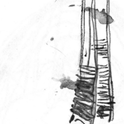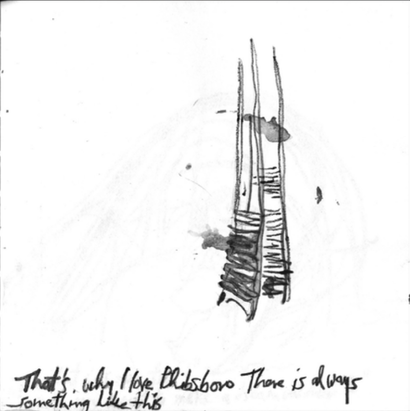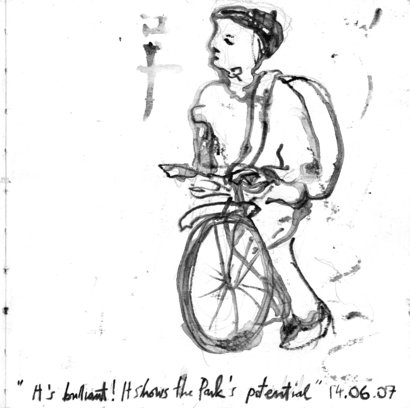
the "Great Willow Weave" sketches
Click here to view A collage of photos and sketches on tumblr
Spatial and social activation of Great Western Square
DESIGN LED RESEARCH______________________________________________________________________
The “Great Willow weaving” is a social practise art project.
In 2010 UCD landscape architecture students and I left the studio for the first time.
We went to study in the landscape instead.
This module is about doing. We go out and work at 1:1 scale in the public realm
…often with the community.
The each- way learning between students and community as they “roam” the neighbourhood together is immense.
In the summer of 2016 Phibsboro Tidy Town approached my practise with a project proposal that I felt was perfectly suited for a student project,
They had received € 500 funding for building a memorial for Phibsboro teenagers who were shot during the Easter Rising.
After spending several mornings exploring Phibsboro and the community’s expectations from a memorial, the students came up with several proposals. The community chose four of them.
With funding promised by Croke Park, UCD and DCC we began planning the Great Willow Weaving in January 2017. Handing out flyers door-to-door and Design- participation- meetings with the residents followed meetings with the resident association. At the same time we were costing the project and putting together a workshop framework and researching willow sculpture building.
We are on site now in June 2017
- Even though we are building objects, the project is process led, an interventionist art piece. The objects are very ephemeral willow installations.
- As we wanted to integrate everyone who came along on, we did not even have plans for what to actually build; we just had a big pile of willow.
- Building what ultimately became a play- sculpture park, we developed it the way children play: One things leads to another, consciously or subconsciously influenced by information gathered on site.
- Sucking up the “Genius loci” as we spend time here. Spending our days here allows us to analyse this space in a more intrinsic manner. Not through measuring it up and interpreting photographs but much more subconsciously and slowly through spending time here…. Knowing where the sheltered space are as we seek shelter ourselves, meeting the residents not through approaching them with clip boards and questionnaires, but them approach us to join in- perhaps after observing what is going on. Of course this is allowing us also to observe the patterns of usage of the Square…. It is a different method of community consultation and site analysis…
- Through being involved in the building process or through interacting with the built artwork the viewer becomes integral to the work itself. This is facilitated through working in a communal public space and with materials and techniques that are very easy to acquire.
- The project is participatory, playful, open ended, inventive and spontaneous and the result is very ephemeral.
- People walking through the Square daily but not actively engaging in the building process do not feel excluded as the work in progress is a very open process, no cordoning off of the “building sites”, no watchman, no warning signs.
- The fragile nature of the willow sculptures allows for easy accidental dismantling. We observe children and even dogs doing so during play. On the flip side this also means that they are easy to repair.
- Collective responsibility for the installations within the community develops fast, they are maintained and repaired on an ongoing basis.
- The willow installations have made the maintenance of the park more time consuming for the local council- where they could previously use a sit on lawnmover they now have to carefully mowe around the installations using a hand- held mower. The Council does that to this day.
- In January 2018, 7 month after the built, five of the original nine installations are still standing. We took two down as they started to look a bit raged, and two were played to the ground or perhaps vandalised. It is interesting to think about that aspect… What is play and what is vandalism?
- The installations were planned to last only a month when we put them up. We told the community that we would take them down anytime they wished. Our contact point is the resident Association. They still have not asked us to take them down, nine month later…. They did wonder though who is going to pay for the maintenance and provide the willow for repair works?
- This Social art project is an inclusive experience aiming to change the way people see and use the park, and perhaps also motivating people to use it who have not before. During the workshop week we found out a lot about why people use or don’t use the park and what they would like to see improved. Not only from the local people who built sculptures but also from the people who walked by and approached us for a chat.
- Of course this project is a social/ political criticism. By temporarily changing their nature of the public realm we are questioning the prescribed way a city functions.
Advantages of a willow sculptural play installation:
- Aesthetically blending in easier into existing park
- Allow to be spread all over the area, so that the play area is not a fenced of or designated space
- Turns the entire park into a playable area for children
- Makes advantages of existing planting and geography
- Due to it’s fragile nature seems to deter vandalism
- Cheap to repair
- Possible to dismantle without leaving a trace
- Every sculpture is unique and can be built to adapt to it’s specific surrounding
- Willow is a natural material with beautiful and varied texture, interacting with the willow sculptures is sensory and heuristic play
- Willow weaving is a kinaesthetic learning experience, you just have to start to learn how to do it
- Willow sculptures promote freely chosen play, what is a house for one child is a boot for the next, great for developing imagination
- Willow sculptures promote psychological shelter, while as being safe, as sufficiently translucent
- It is totally inclusive: Every child
- Children develop their hand- eye coordination and fine motor skills weaving willow
- Children really concentrate when they weave
- It allows children to be creative when they weave
- All age groups from one year old to teenagers are attracted by the sculptures and interact
- Willow weaving is an ancient Irish craft tradition
- They act as “docking spaces” families who settle down on the grass will do so next to a sculpture
- Research has shown that there are many mental and physical benefits from playing in “nature- Inspired” playgrounds



 back to index
back to index

